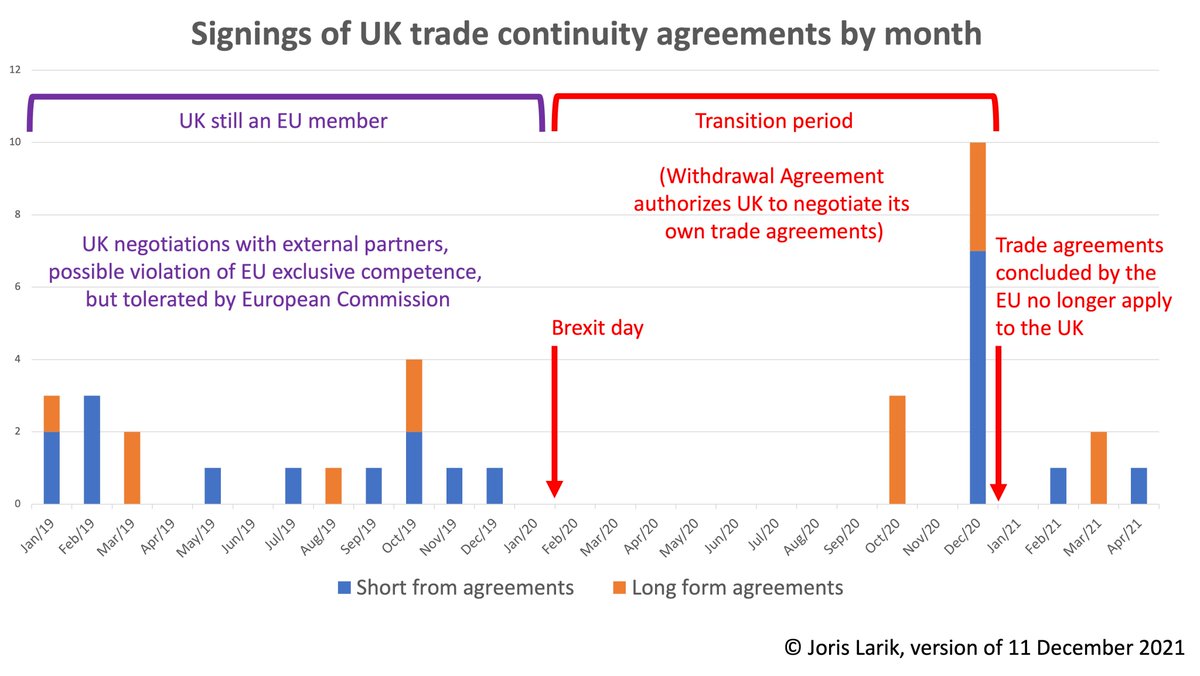
I'm currently doing a systematic analysis of the UK's post-#Brexit trade "continuity agreements" for my fellowship at @NIAS_KNAW.
It yielded this chart visualising the history of this programme to date. 👇
Here's a short thread about what it tells us... 1/
It yielded this chart visualising the history of this programme to date. 👇
Here's a short thread about what it tells us... 1/

2/ To recap: By leaving the EU, the int'l agreements concluded by the EU with 3rd states cease to apply to the UK. As practice has shown, this includes "mixed agreements" to which the UK was party alongside the EU. This concerned also the EU's trade agreements 👇 (map not by me) 

3/ Faced with the possibility of a #NoDealBrexit, the UK gov't negotiated & signed 18 continuity agreements already while the UK was still an EU member state. This was possibly a violation of EU exclusive competences, but the Eur. Commission did not take legal action.
4/ The Withdrawal Agreement (in Article 129) allowed the UK to negotiate its own trade (and other) agreements, as long as these would only enter into force *after* the end of the transition (= 1 January 2021). It also stated that the EU's int'l agreements still applied to the UK.
5/ During the transition period, not much signing activity happened until October 2020. A true "signing frenzy" happened right on time before the end of the transition period, with 10 continuity agreements being signed in December 2020.
6/ The UK government, @tradegovuk in particular, succeeded in "rolling over" most EU trade agreements on time, including the economically important ones w/ 🇨🇦🇯🇵🇰🇷🇹🇷🇨🇭🇸🇬. This was no small feat, certainly no quick "copy paste" job for at least three reasons:
7/
1) UK didn't have a department of int'l trade before 2016;
2) UK was preoccupied with negotiations with the EU on future relations;
3) 3rd countries were not obliged to roll over these agreements and give the UK similar terms to the EU's, despite being a smaller market.
1) UK didn't have a department of int'l trade before 2016;
2) UK was preoccupied with negotiations with the EU on future relations;
3) 3rd countries were not obliged to roll over these agreements and give the UK similar terms to the EU's, despite being a smaller market.
8/ The UK used two different formats for the continuity agreements: 1) "short form" = incorporating the EU agreement by reference and noting what's modified; 2) "long form" = a fully written out agreement largely replicating the content of the original EU agreement.
9/ The majority of these agreements are "short form", but both long and short form have been used throughout the programme.
Often, but not always, EU-specific concepts have been taken over by the UK, such as "association", "essential elements" and "effective multilateralism".
Often, but not always, EU-specific concepts have been taken over by the UK, such as "association", "essential elements" and "effective multilateralism".
10/ (if you've made it this far in the thread...)
A more detailed and normative assessment of the treaty continuity programme is in the works. So stay tuned!
The texts of the agreements and other information are available here: gov.uk/guidance/uk-tr…
A more detailed and normative assessment of the treaty continuity programme is in the works. So stay tuned!
The texts of the agreements and other information are available here: gov.uk/guidance/uk-tr…
• • •
Missing some Tweet in this thread? You can try to
force a refresh



